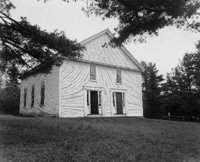
[The first Seventh-day Adventist Church Building]
Founded
Its birthplace in the township of
Washington, New Hampshire, in 1844, reveals three
central truths about the history of the Seventh-day
Adventist Church.
1. Before it was "Adventist" or Sabbath keeping
Adventist, it was "Christian."
2. It celebrates a history that has emphasized
"freedom."
3. It welcomes and grows from diversity within its
membership.
The Christian Roots of Seventh-day Adventism
The local church where "Christian," "Advent," and
"Sabbath" combined was established by Christian
Connection believers, a religious body that in the
mid-nineteenth century was fifth in membership within
the United States.
Members of the Christian movement sought biblical
authority for every aspect of belief. They wanted "no
creed but the Bible." Thus, if they were convinced from
the Scriptures of the literal soon advent of Christ and
the continuing validity of the seventh day Sabbath,
their heritage demanded acceptance.
Because William Miller, a well-known Baptist preacher,
exhibited profound knowledge of the Scriptures as he
lectured upon the literal soon advent of Christ, scores
of Christian Connection churches and many of its
ministers and leaders became "Adventist" in the late
1830s and 1840s. The Washington, New Hampshire,
Christian Connection church by the early 1840s was an
"Adventist" church.
Social, Organizational, and Theological Freedom
Another element of the Seventh-day Adventist heritage
from "Christians" involves the Seventh-day Adventist
emphasis upon freedom.
Washington, New Hampshire, was the initial town in the
United States to name itself after George Washington,
and it took that name in 1776, the year of the American
Revolution. Its very birthplace seemed a call to
personal freedom.
"Christians," as did Seventh-day Adventists from their
earliest days, actively sought freedom for all and
worked toward abolition of slavery as well as roles for
women in the church, and fostered a strong opposition to
formalized church creeds.
Freedom was also emphasized through an orientation
toward temperance and health reform. Proper care of the
physical frame would yield a clear mind with which to
perceive scriptural truths.
Thus within nineteenth-century Adventism one finds
strong anti-slavery actions, women licensed as
ministers, and health reform principles that included
abolition of alcohol and tobacco within the membership.
Religious freedom came to mean more than the separation
of church and state. It also implied a right to read the
Scripture for oneself and come to conclusions not bound
by creedal presuppositions. The "present truth"
perspective assumed that new insights would arise as
Seventh-day Adventists continued to study the
Scriptures. The prophetic guidance of Ellen White within
the movement solidified this perspective of social,
organizational, and theological freedom.
A Diverse Movement
The Washington, New Hampshire, roots also illustrate the
diversity within the heritage of Seventh-day Adventists.
It was Rachel Oakes, a Seventh Day Baptist, that
convinced some of the members of the Washington church
about the continuing validity of the seventh-day
Sabbath. Not all mid-nineteenth century churches would
give a fair hearing to the insights of a woman. Besides
that, Thomas Preble, who attended that church and wrote
an influential tract on the seventh-day Sabbath, was a
Freewill Baptist. Frederick Wheeler, who served as their
pastor, was a Methodist minister. We thus have
substantial diversity within that original church. At
least five different religious faiths formed the first
Sabbath keeping Christian Adventist church. Within that
diversity, however, unity over central issues prevailed.
Shortly after settling on a denominational name in 1860,
Seventh-day Adventists began to talk about a worldwide
movement. After all, didn't Christ urge to "go ye into
all the world, and preach the gospel to every creature"
and didn't Revelation talk of "the everlasting gospel"
to be proclaimed to "them that dwell on the earth, and
to every nation, and kindred, and tongue, and people"?
In 1861 it was discovered that at least five in Ireland
were practicing Seventh-day Adventists. But how could a
group of only a few thousand perform the task of
worldwide evangelism? The denomination was officially
organized on May 21, 1863, when the movement included
some 125 churches and 3,500 members. By 1864 Michael
Belina Czechowski, a former Catholic priest, decided to
spread the Seventh-day Adventist message throughout
Europe. In 1874 the church was ready to send abroad its
first official missionary, J. N. Andrews, who left the
United States for Switzerland. By the end of the century
Seventh-day Adventism had become worldwide in scope.
Today some 10 million Seventh-day Adventists have
established themselves in virtually every country of the
world. Less than 10 percent of Seventh-day Adventists
live in the United States. While ethnically diverse,
they remain united over the everlasting gospel, the
basic Christian message of salvation through faith in
Christ. Unity prevails also over the other central
teachings of their Christian heritage.
The Heritage Continues
While Seventh-day Adventists arose within an apocalyptic
movement that stressed the nearness of the Second
Advent, their "Christian" heritage emphasized the
down-to-earth implications of the ministry of the
Saviour. The tension between "today" and "later" gives a
unique power to the way Adventists serve in their
communities. It has focused the energies of church
members into education, publishing, the healing arts,
community service, and any other activities that allow
them to talk about their faith while improving the lives
of their neighbors.
One result of this desire to touch lives for God is that
Adventists have built thousands of schools around the
world. It also means that Seventh-day Adventist
physicians and medical institutions serve individual
needs in more than 98 countries, giving the highest
possible quality of personal care whenever people hurt.
These physicians, nurses, therapists, and other medical
workers have dedicated their lives to providing physical
healing so that each person can live the best possible
life. Using modern medical knowledge and carefully
developed skills, these workers touch thousands of lives
each day, bringing healing and hope into families around
the world.
Schools, hospitals, clinics, and health food factories
are just one small corner of the Seventh-day Adventist
commitment to improving lives. There is much more:
Wherever disaster strikes, ADRA, the Adventist Development
and Relief Agency, joins hands with other organizations
to provide clean water, food, clothing, housing, and
care.
Adventist publishing houses produce inspirational books,
textbooks, Bible commentaries, health books, and dozens
of specialized magazines in scores of languages each
month. These are then delivered to millions of homes
around the world, providing quality reading and
information that improves lives.
Local Adventist churches serve their communities by providing
recreational and social activities for children and
teenagers, vocational and evening education programs for
adults, and spiritual programming and health clinics for
all.
On a worldwide scale, the church's mission activities are
exemplified in the Global Mission initiative-to reach
the unreached peoples of the world for Christ.
Summer camps offer all sorts of activities-from horseback
riding and waterskiing to crafts and dozens of other
youth activities in country environments in which
children feel safe and loved. These activities are
combined with a witness for God's message to make people
whole-physically, mentally, socially, and spiritually.
Use of modern technology also describes Adventist commitment
to mission and presence in the society with messages of
"Good news." Numerous radio studios dot the Adventist
broadcasting map around the globe. The same goes for
production of television and other media programs. The
church's interest is best exemplified in a satellite
broadcast system with more than 14,000 downlink sites,
and the television 24/7 global broadcasting network for
homes, the Hope Channel.
Too often it's easy to see all of this as just
activities of the institutions and organizations of the
church. But the Seventh-day Adventist Church is far more
than its organizational structure and institutions. The
Adventist Church is people, individual members who have
caught a vision and who have chosen to live out that
vision for Christ, as His hands of hope.



